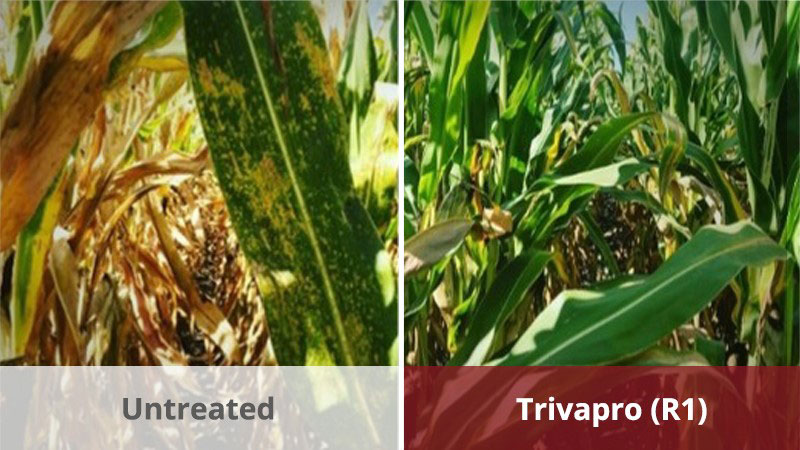79% of Corn Growers Who Used Trivapro Fungicide Maximized ROI

Grower field | Leonard, MO 2017
Each season, growers have to decide if they want to invest in a fungicide. At the end of the day, selecting the right fungicide comes down to the numbers. At the end of the season, will there be a positive return on investment?
When dealing with the unpredictable nature of disease, growers need a product that performs consistently and provides ROI they can count on. This season, consider Trivapro® fungicide.
Based on performance in the past 2 years, Trivapro growers are convinced it is the hardest-working, longest-lasting disease protection option available, consistently increasing yield and boosting plant health in corn, soybeans and wheat.
In 2017, 79% of corn growers who used Trivapro made a profit1, and growers and retailers had a lot to say about the results from the field.
Matthew Hampton, a corn and soybean grower from Morgantown, KY, shared, “When corn fungicides first came out, years ago I tried it, but didn’t see much advantage. Now, with Trivapro, we’ve changed our minds. We’re basically going to use it on all of our acres.”
What has growers convinced?
“Solatenol® fungicide, the SDHI component of Trivapro, extends the length of control weeks longer than other brands. This means that when disease comes in late in the season, it’s still working when other fungicides have quit. This allows the Trivapro-treated plant to dry down naturally, extending the grain-fill window, when other plants are dying down early from disease,” explained Brett Johnson, Syngenta fungicide product lead.
Jeremy Sollberger – a retailer at Southern States in Campbellsville, KY – said, “At $3.50/bu corn, a 10-bushel yield increase will more than cover the cost of application of the fungicide2. We’re seeing a 20-plus bushel increase with Trivapro, so that’s 70 dollars of revenue in the producer’s pocket. I don’t know what else they’re going to do during the season to put $70 in their pocket.”
These results are widespread throughout various states and crops. Compared to untreated, Trivapro produced an average of:
- 6.7 bu/A more soybeans3
- 13 bu/A more wheat4
- 18.5 bu/A more corn5
“Across all of our trials from 2016 and 2017, we’ve seen an average ROI of $37.75 per acre in corn, and growers can take that to the bank,” said Johnson6.
Visit NotAfraidToWork.com or contact your local Syngenta sales representative to learn more about Trivapro.
All photos are either the property of Syngenta or are used with permission.
Product performance assumes disease presence.
Performance assessments are based upon results or analysis of public information, field observations and/or Syngenta evaluations.
©2018 Syngenta. Important: Always read and follow label instructions. Some products may not be registered for sale or use in all states or counties. Please check with your local extension service to ensure registration status. Solatenol®, Trivapro®, and the Syngenta logo are registered trademarks of a Syngenta Group Company.
1 ROI calculation based on commodity price of $3.50/bu corn, Trivapro cost of $17/acre and $10 R1 application cost. Data from 138 non-replicated trials in the U.S. in 2016-2017.
2 Calculation based on $10/acre application cost and $17/acre fungicide cost.
3 Based on 20 non-replicated trials in the U.S. in 2017.
4 Based on 21 replicated trials in the U.S.
5 Based on 138 non-replicated trials in the U.S. in 2016-2017.
6 ROI calculation based on commodity price of $3.50/bu corn, $10/acre application cost and $17/acre fungicide cost.
